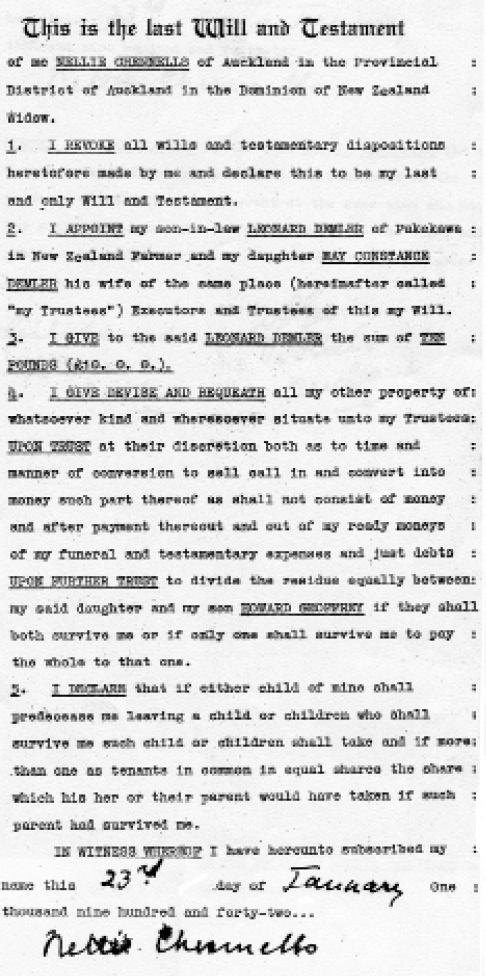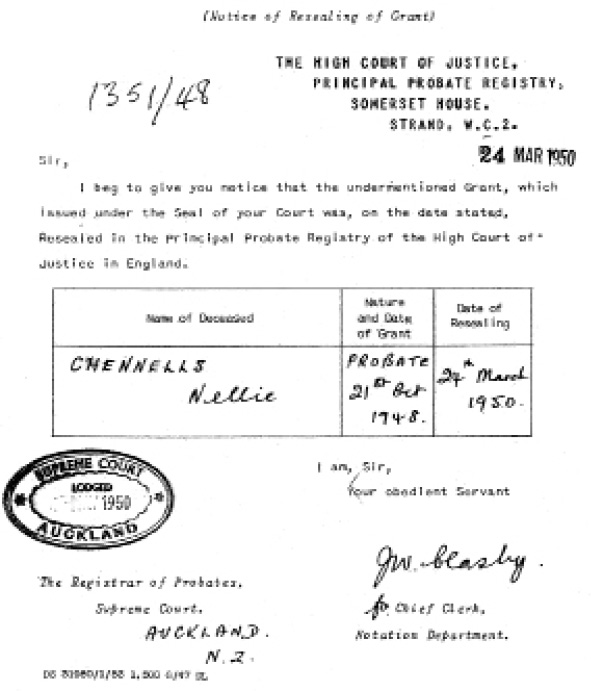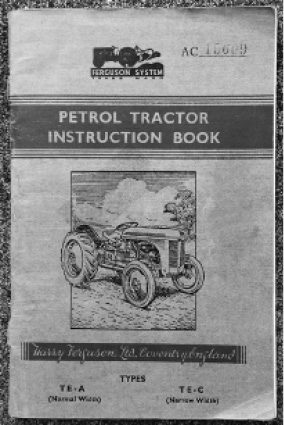Using her birth year of 1873 Nellie Chennells would have been aged around 40 when she arrived in New Zealand and as a cross reference, her husband was listed on the 1911 electoral roll which makes the dates close enough to add up and work with . . .
The big question that has to be asked is why Newman and Nellie Chennells would want to move to the other side of the world. An even larger question could be why Newman arrived a year or so earlier than his wife Nellie and children.
After around 12 years of marriage and faced with raising a family after a crippling accident to his wife, either through medical misadventure or vehicle accident, the prospects of starting afresh must have looked more appealing.
New Zealand was promising to be a land of opportunity and it was, particularly in real estate. We know Newman brought his skills in the trade from England and he become quite adept in the art of wheeling and dealing.
My gut feeling has always been that land and money, whether it is in England or New Zealand, is the overwhelming factor behind the awful tragedies that occurred in 1970.
Everyone’s thoughts were diverted away from finding out what really happened. So who was controlling or driving the events that led up to the tangled mess of deceit and shady dealings?
The justice system did fail in its duty and the so-called law of the land was used, without conscience, to falsely convict one of many suspects. My only hope is that the information revealed in this book will bring the real culprits to justice.
Without letting the cat completely out of the bag, I must follow my instincts by providing enough ammunition to point fingers towards the ones that may be deeply involved and to a certain extent to those on the fringes.
CONTROL OF FINANCES AND TRUSTS
Now, back to my question of who was really controlling the finances and trusts.
Was it Nellie Chennells from her wheelchair after the death of her husband Newman in 1938 or her daughter Maisie who inherited her mother’s estate after her death in 1948?
At this stage I do not believe a single person controlled the wealth but it was more about the way ‘the system’ was allowed to be manipulated by the trustees of the various estates.
The first clues I had towards things not quite sounding right were found in the last Will and Testament of Newman Chennells. The part where his wife Nellie was not eligible to any entitlements from his estate got my attention. This is not normal and led me to believe her legacies were a separate issue especially when dealing with land mentioned by him in England.
The point I made earlier in this text was of the implications indicating that any other part of his estate and legacies not already put through the probate of Newman Chennells would be able to be claimed solely by Nellie particularly the separate estate in England.
I also stated that it is not until Nellie’s 1948 will is read that Newman’s intentions would be understood.
I made a bold statement that “skulduggery was lurking on the horizon”. Nellie’s will revealed very little as her real intentions and these may have been hidden by her solicitor’s choice of words. While being politically correct, it would become obvious later on that indeed “skulduggery was lurking on the horizon”.
Nellie’s affairs were handled by an Auckland firm of solicitors Glaister, Ennor & Kiff. Others “in the know” would have included her late husband’s trustees, Alf Hodgson, including solicitor Colin Sturrock and at the top of the list were Len and Maisie Demler and quite possibly other family members.
Nellie’s last Will and Testament is reproduced opposite with particular reference being made to Clause 4 for the possibly hidden meanings. She talks of other property “wherever situated” which would include, if people knew about it, in England or elsewhere around New Zealand. She next mentions converting into money parts that “shall not consist of money”. While this is common terminology, in translation this could mean in addition to property previously mentioned, shares, bonds, or other assets intended to be converted to “residue” (which it technically is).
Finally she is instructing that the “residue” (anything that is left over after expenses) is divided equally between her daughter Maisie and son Howard “if they shall both survive me or if only one shall survive me to pay the whole to that one.”
In plain language each would inherit half each of her estate but she adds another (standard) clause that says if either of her children predecease her then, in this case, her estate would go to her grand daughters, Jeannette and Heather as tenants in common.
While her intentions were clear, fate was about to step in–or was it skulduggery? Whether intentional or not, greed raised its ugly head.
FOLLOWING THE LEGAL PROCESS
First, before the complications creep in, I want to follow the legal process as I believe it is important to mention here that there were actually two probates, one for her New Zealand estate and the other for “effects” in England registered in Nellie’s name.
Both probates are dealt with differently in each country, but broadly speaking a receipt of probate is required as the first step in administering the estate of a deceased person and ends with the probate registry issuing a legal document called a Grant of Probate. This means the will has been proved to be valid and the probate can now be used to resolve all claims and to distribute the deceased person’s property under the intentions of the will.
The New Zealand probate was quite simple being granted on 21 October 1948 but it took some time, around eight months after the death of Nellie, for her solicitors, Glaister Ennor & Kiff, to file an Exemplification of Probate for England in the Auckland Supreme Court.
Due process was carried out in England to find the original document listing Nellie’s effects then checking for proof of their existence. To be honest, I have no idea what the document actually contained but I found an entry on the England & Wales National Probate Calendar for 1950 stating: Effects £664/1/5. Sealed London 24 March.
The £664 figure was a lot of money in 1952 but probably not enough to literally kill for. So what else was on Nellie’s list, for I’m certain there was more?
Not being privy to this information has been one of the biggest thorns in my side and not knowing the answers has nearly sent me to an early grave. I’ve been right on the edge of uncovering this mystery many times but I hate to admit that I have been beaten on every occasion by the bureaucratic system, especially in the UK.
RESEALING OF GRANT OF PROBATE
Right now I want to go back to the date of 24 March 1950 that is shown on the official documents filed in England.
The other document with the same date was received from Somerset House. It confirms the Notice of Resealing of Grant was dated 24 March 1950 and was issued from the Principal Probate Registry of the High Court of Justice in England. The same document was shipped on a slow boat back to New Zealand and according to the rubber stamp was lodged in the Auckland Supreme Court on 4 May 1950.
It had taken one month short of two years after Nellie’s death for the UK probate to be returned into the hands of the trustees, Len Demler and his wife Maisie.
Meanwhile, a very scary event occurred 17 days after it was lodged. It has already been mentioned on previous pages that Maisie’s brother Howard Chennells was accidentally killed in a tractor accident on his farm on 21 May 1950.
Those with a suspicious mind would wonder if this unfortunate accident was really an accident. Maisie now found herself as the sole survivor and inherited her mother’s UK and New Zealand estates. Was this merely a trick of fate due to delays beyond her control or were the UK documents deliberately delayed long enough for the trustees to ponder their options?
Regardless that a will “speaks from the date of death” and not the date of probate, my mind was starting to work overtime. Apart from a solicitor, only two people would know that the documents had arrived and one of these people could have easily “doctored” the tractor.
It is at this point that I remembered being told by a local that a set of counterweights were seen lying in the grass by a fence on the day the accident happened along with Howard’s lunch box.
In joining up some dots with this seemingly unimportant comment and what I knew about the possibility of Maisie being the sole survivor of the family fortune, it would have been as simple as removing the counter weights from the front wheels then hoping Howard would take his tractor up one of the steep slopes, manoeuvres he had safely done many times before.
It had been a surprise to everyone that this very experienced tractor driver had been caught out so was Howard really simply over confident?
If local folklore is correct then it makes my hair stand on end to think that this set of coincidences could have actually happened with a bit of outside help.
CHECKING OUT THE FACTS
To set my mind at rest, I borrowed a pre 1950 Ferguson tractor instruction book from a Hamilton dealer in old tractor parts to check whether these tractors actually had counterweights on the front wheels.
In spoiling a good story with the facts, the dealer told me that ‘Fergie’ counterweights did not appear until the mid 1950s.
The dealer went on to explain how easy it was to tip a Fergie tractor over backwards. Without getting too technical he said as more power was applied to drive up a steep bank and if the back wheels didn’t spin, the pinion would climb up the crown wheel and in an instant would flip over backwards.
He added that tractors of this design were known as “widow-makers” while other makes that ran in the opposite direction resulted in the pinion driving down the crown wheel and thereby overcoming the problem.
It was interesting to note on page 9 of the instruction manual that if a drawbar was fitted, it could be raised and lowered from its normal setting of 18 inches from the ground. It would then affect the traction. Traction would be increased with trailed machinery by raising the drawbar or if lowered “the drawbar would tend to keep the front end of the tractor down at the expense of some loss of traction.”
It is not known if Howard’s Fergie had a drawbar so one can only draw a conclusion that it was indeed an accident. In saying that, his accident was only one of a number of other questionable fatalities in the area around this time.
WHO BENEFITS?
If this was a genuine accident it would mean that Maisie really won by default due to surprisingly good luck rather than good management.
There are still a lot of ‘ifs and buts’ surrounding this saga and I have constantly toiled with the ‘what ifs’ and whether anything would have dramatically changed if Howard’s share of his mother’s assets in England had actually gone into his estate instead of being controlled by Maisie or, dare I say it, eventually by Len Demler!
His nieces, Jeannette and Heather Demler, would have benefited in the long run whichever track it went down as they would have eventually inherited after the death of their mother, Maisie.
That is, providing both were still alive at the time and that Maisie didn’t change her will!






Leave a Reply